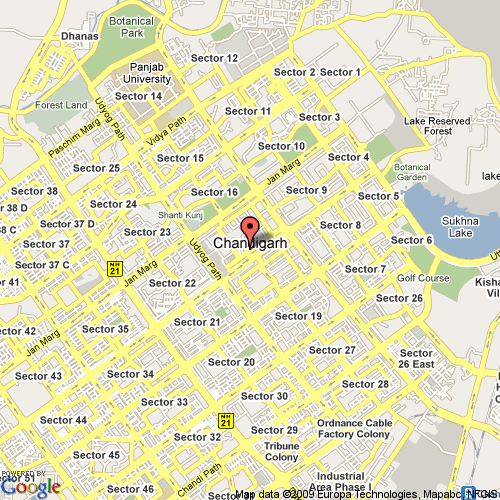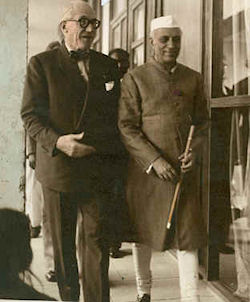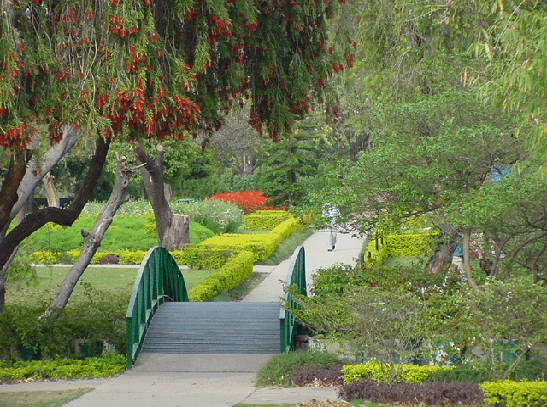Chandigarh, know as The City Beautiful, a Union Territory, and the capital of Punjab and Haryana in north India is also named as “the best place to live” and the “most planned city” in India.
The city of Chandigarh was conceived immediately after India‘s Independence in 1947. With the partition in the subcontinent, Lahore, the capital of undivided Punjab fell within Pakistan, leaving East Punjab without a Capital. It was decided to built a new Capital city called Chandigarh about 240 kilometers north of New Delhi on a gently sloping terrain with foothills of the Himalayas the Shivalik range of the North and two Seasonal rivulets flowing on its two sides approximately 7-8 kms apart.
Nehru’s Vision
Pandit Jawaharlal Nehru, Independent India’s first Prime Minister, laid down the founding principles of the new city when he said “Let this be a new town, symbolic of freedom of India unfettered by the traditions of the past….. an expression of the nation’s faith in the future”.
The Perfect Site
To select a suitable site, the Government of Punjab appointed a Committee in 1948 under the Chairmanship of Sh. P.L Verma, Chief Engineer to assess and evaluate the existing towns in the State for setting up the proposed capital of Punjab. However, none was found suitable on the basis of several reasons, such as military vulnerability, shortage of drinking water, inaccessibility, inability to cope influx of large number of refugees, etc. The present site was selected in 1948, taking into account various attributes such as its central location in the state, proximity to the national capital, availability of sufficient water supply, fertile soil, gradient of land for natural drainage, beautiful site with the panorama of blue hills as backdrop, & moderate climate.
French, Swiss & American Architects
An American Firm, M/s. Mayer, Whittlessay and Glass was commissioned in 1950 to prepare the Master Plan for the new City. Albert Mayer and Mathew Novicki evolved a fan shaped Master Plan and worked out conceptual sketches of the super block. The super block was designed as a self-sufficient neighborhood units placed along the curvilinear roads and comprised of cluster type housing, markets, and centrally located open spaces. Novicki was tragically killed in an air accident and Mayer decided to discontinue. Thereafter, the work was assigned to a team of architects led by Charles Eduard Jeanneret better known as Le Corbusier in 1951.
He was assisted by three senior architects, Maxwell Fry, his wife Jane B Drew and Corbusier’s cousin, Pierre Jeanneret. These senior architects were supported by a team of young Indian architect and planners. The major buildings designed by these architects are the important landmarks in the city
Chandigarh-The City Beautiful
Picturesquely located at the foothills of Shivalik hills, Chandigarh is known as one of the best experiments in urban planning and modern architecture in the twentieth century in India. Chandigarh derives its name from the temple of “Chandi Mandir” located in the vicinity of the site selected for the city. The deity ‘Chandi’, the goddess of power and a fort of ‘garh’ laying beyond the temple gave the city its name “Chandigarh-The City Beautiful”.
The city has a pre-historic past. The gently sloping plains on which modern Chandigarh exists, was a wide lake ringed by a marsh. The fossil remains found at the site indicate a large variety of aquatic and amphibian life, which was supported by that environment. About 8000 years ago the area was also known to be a home to the Harappans.
The Capital City
Since the medieval through modern era, the area was part of the large and prosperous Punjab Province, which was divided into East & West Punjab during partition of the country in 1947. The city was conceived not only to serve as the capital of East Punjab, but also to resettle thousands of refugees who had been uprooted from West Punjab.
In March, 1948, the Government of Punjab, in consultation with the Government of India, approved the area of the foothills of the Shivaliks as the site for the new capital. The location of the city site was a part of the erstwhile Ambala district as per the 1892- 93 gazetteer of District Ambala. The foundation stone of the city was laid in 1952. Subsequently, at the time of reorganization of the state on 01.11.1966 into Punjab, Haryana and Himachal Pardesh, the city assumed the unique distinction of being the capital city of both, Punjab and Haryana while it itself was declared as a Union Territory and under the direct control of the Central Government.
The Open Hand
Le Corbusier conceived the master plan of Chandigarh as analogous to human body, with a clearly defined head (the Capitol Complex, Sector 1), heart (the City Centre Sector-17), lungs ( the leisure valley, innumerable open spaces and sector greens), the intellect (the cultural and educational institutions), the circulatory system (the network of roads, the 7Vs) and the viscera (the Industrial Area). The concept of the city is based on four major functions: living, working, care of the body, and spirit and circulation. Residential sectors constitute the living part whereas the Capitol Complex, City Centre, Educational Zone (Post Graduate Institute, Punjab Engineering College, Panjab University) and the Industrial Area constitute the working part. The Leisure Valley, Gardens, Sector Greens and Open Courtyards are for the care of body and spirit. The circulation system comprises of 7 different types of roads known as 7Vs. Later on, a pathway for cyclists called V8 were added to this circulation system.
The Capital complex comprises three architectural masterpieces: the “Secretariat”, the “High Court” and the “Legislative Assembly”, separated by large piazzas. In the heart of the Capital Complex stands the giant metallic sculpture of The Open Hand, the official emblem of Chandigarh, signifying the city’s credo of “open to given, open to receive”.
The city centre (Sector 17) is the heart of Chandigarh’s activities. It comprises the Inter-State Bus Terminus, Parade Ground, District Courts, etc. on one hand, and vast business and shopping center on the other. The 4-storey concrete buildings house banks and offices above and showrooms/shops at the ground level with wide pedestrian concourses. The Neelam piazza in the center has fountains with light and water features. Proposal to set up an eleven storey building in Sector 17 is in the offing. Sector 34 is another newly developed commercial sector.
Parks and Sectors
Ample areas have been provided in the master plan of the Capital for parks. Out of a total area of 20,000 acres acquired for the first phase, about 2,000 acres are meant for development of parks. Leisure Valley, Rajendra park, Bougainvillea Park, Zakir Rose Garden, Shanti Kunj, Hibiscus Garden, Garden of Fragrance, Botanical Garden, Smriti Upavan, Topiary garden and Terraced Garden are some of the famous parks of Chandigarh. Sukhna Lake, Rock Garden, Government Museum and Art Gallery are major tourist attractions of Chandigarh.
One unique feature in the layout of Chandigarh is its roads, classified in accordance with their functions. An integrated system of seven roads was designed to ensure efficient traffic circulation. Corbusier referred to these as the 7’Vs. the city’s vertical roads run northeast/southwest (the ‘Paths’). The horizontal roads run northwest/southwest (‘The Margs’). The intersect at right angles, forming a grid or network for movement.
This arrangement of road-use leads to a remarkable hierarchy of movement, which also ensures that the residential areas are segregated from the noise and pollution of traffic.
Each ‘Sector’ or the neighboured unit, is quite similar to the traditional Indian compound. Typically, each sectors measures 800 metres by 1200 metres, covering 250 acres of area. Each Sector is surrounded by V-2 or V-3 roads, with no buildings opening on to them. Each Sector is meant to be self-sufficient, with shopping and community facilities within reasonable walking distance.
Though educational, cultural and medical facilities are spread all over city, however, major institutions are located in Sectors 10, 11, 12, 14 and 26.
The industrial area comprises 2.35 sq kms, set-aside in the Master Plan for non- polluting, light industry on the extreme southeastern side of the city near the railway line, as far away from the Educational Sectors and Capitol Complex as possible.
Tree plantation and landscaping has been an integral part of the city’s Master Plan. Twenty six different types of flowering and 22 species of evergreen trees have been planted along the roads, in parking areas, shopping complexes, residential areas and in the city parks, to ameliorate the harsh climate of the region, especially the hot and scorching summers.
~ Published by Chandigarh government



